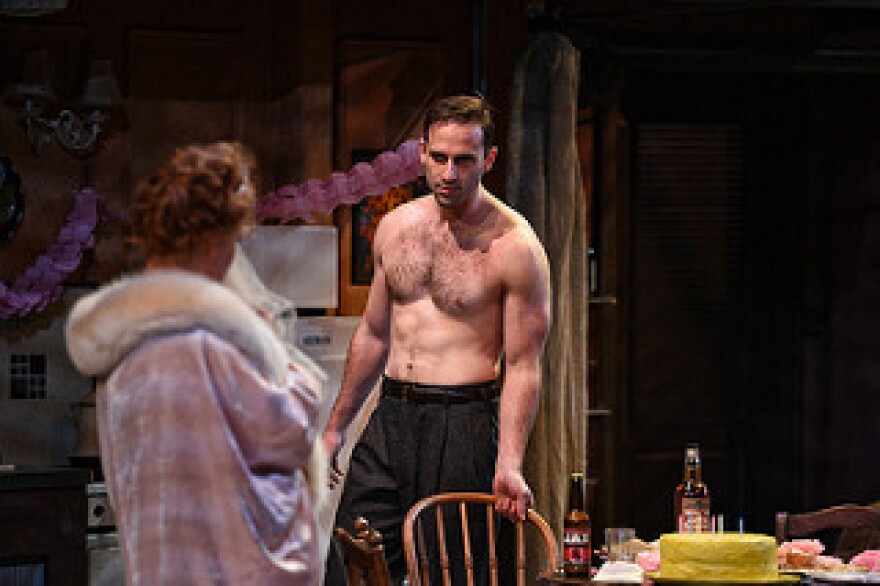
Everyman Theatre is promoting this season’s final two plays as “The Great American Rep.” According to the theater, this is the first time Arthur Miller’s “Death of a Salesman” and Tennessee Williams’ “A Streetcar Named Desire” have been performed in rotating repertory.
But why these two? Besides being two of America’s greatest dramatic masterpieces, what do they have in common?
For starters, as the cover of Everyman’s program reminds us, the protagonists in both plays show up carrying suitcases. In “Death of Salesman,” Willy Loman cuts a sales trip short and returns home, lugging his suitcase and a heavy sample case. In “Streetcar,” Blanche DuBois no longer has a home and arrives at her sister’s New Orleans’ apartment, suitcase in hand.
What’s in these suitcases? Clichéd as it may sound, the suitcases are stuffed with dashed hopes and dreams.
Discovering why this happened, and its effect on Willy and Blanche, is the core of each play. The two protagonists receive distinctive – atypical – interpretations at Everyman. In “Death of a Salesman” – the more powerful production – the interpretation of Willy Loman enhances the play’s impact; in “Streetcar,” a less-layered interpretation of Blanche decreases the impact.
Pairing the plays accentuates something else they share. Arthur Miller’s original title for “Death of a Salesman” was “The Inside of His Head.” Seeing the plays together emphasizes that Willy and Blanche both have other worlds – past worlds -- going on in their heads.
At various points in “Death of a Salesman,” Willy becomes disoriented and slips back into his past. Director Vincent M. Lancisi and lighting designer Harold F. Burgess II stage these episodes so seamlessly, they truly seem to take us into Willy’s muddled mind.
When actor Wil Love’s heart-wrenching, broken-down Willy Loman pleads with his young boss – played Bruce Randolph Nelson -- it’s no wonder Willy brings up the past, it’s as alive to him as the present.
In director Derek Goldman’s “Streetcar,” Blanche also drifts into the past, especially when something triggers memories of her long-ago tragic marriage. In these moments, actress Beth Hylton’s Blanche retreats into herself. Chas Marsh’s sound design intensifies her trance-like state.
But Everyman’s “Death of a Salesman” ultimately has a stronger impact. Wil Love is a strikingly singular, milder Willy Loman than usual. The result earns this iconic character even more empathy. Willy’s flare-up against his wife – played with deep devotion by Deborah Hazlett – is less extreme, and so is his favoritism of his older son Biff.
Chris Genebach’s compelling portrayal of Biff is a revelation. Genebach shows this lost son finally wising up and understanding who he really is. When Biff decides to leave for good, the atmosphere in the house could choke you.
Atmosphere is something director Derek Goldman heightens in “A Streetcar Named Desire.” At the start of the production, and between scenes, Goldman fills the stage with New Orleans genre scenes – a sailor, a hooker, food vendors. There’s also a singer, Kelli Blackwell, crooning period standards and, at times, wordless melodies that sound more like cries than music.
But the production is muted by a depiction of Blanche that’s too high-strung from the start. When Beth Hylton’s Blanche descends into hysteria, it’s a short step.
Danny Gavigan brings greater breadth to Blanche’s crude brother-in-law, Stanley Kowalski. Yes, he’s brutish from the get-go, but his rough nature is initially tempered by his love for his wife, Stella, played by Megan Anderson as a young woman with her eyes wide open. Gavigan’s range makes Stanley’s climactic scene with Blanche all the more disturbing.
Performing “A Streetcar Named Desire” and “Death of a Salesman” in rotating repertory is no small undertaking. Most of the actors appear in both – Gavigan, for instance, is Stanley in “Streetcar” and the younger Loman brother in “Salesman.”
Designer Daniel Ettinger’s scenery uses the same cityscape background, but impressively converts from a middle-class Brooklyn home to a squalid New Orleans tenement.
Does seeing “Salesman” and “Streetcar” in rep illuminate anything new? Maybe not. But it does reinforce certain themes, particularly the tattered state of the American dream – a theme that delivers as sharp a sting now as it did when these plays were new.
“Death of a Salesman” and “A Streetcar Named Desire” continue at Everyman Theatre in rotating repertory through June 12




